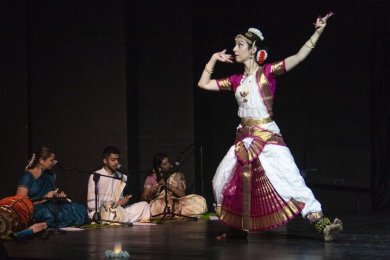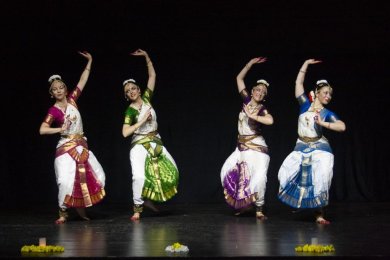
|   |

|   |
Malika: a unique garland - Anjelli Wignakumar & Sharone Balarajah e-mail: anjelli.wignakumar@gmail.com / sharone_b@hotmail.co.uk July 8, 2018 Being students of Guru Usha Raghavan, we heard great reviews of Annalisa Miglorini. Combining her skill as a choreographer with an esteemed orchestra from London and students of Kalasagara Roma, it made for a compelling argument to make the trip to Rome for this performance on 25th June. It was a trip worthwhile. Many performances in today's day and age explore fusion and modern concepts. However, this performance followed an original margam structure which was refreshing and emphasised the traditional way the evening was conducted. Within the margam, the pieces that were chosen were performed in such a way that its essence remained but showed stylistic variations in formations and adavus. The all Italian dance group comprising Giulia Borraccino, Laura Chronopoulou, Francesca Elia, Valeria Vespaziani, have been trained in Bharatanatyam by Annalisa in Rome. The dancers danced with elegance and poise, clearly displaying deep understanding of the art form and its origins. This was best displayed during the abhinaya pieces and during sanchari bhavam sections. It was aesthetically pleasing to see Annalisa's interpretations of the pieces performed. In Thodayamangalam, three dancers held a combined pose relevant to the lyrics of that section whilst the other dancer performed the thattu mettu. This is something we had never seen earlier despite having seen this piece many times before; it was unique, beautiful and powerful. The Sabdam (Sarasi Jakshulu) that followed is one we have learnt, performed and watched many a time, however we thoroughly enjoyed watching it again. The bhavam that Laura and Francesca displayed allowed us to feel involved and connected to the storyline. Their unique take on the pieces was inspiring. Varnam is considered the crowning piece in a margam, but always one of the biggest challenges for a dancer, let alone a group choreography of a varnam. It was evident from their bhavam that all four dancers enjoyed it and were completely lost in the music, which is always a pleasure to watch as an audience member.  Annalisa executed the nattuvangam with clarity, held the orchestra well and given her first language is Italian, her pronunciation of the solkattu of the jathis was very good. We have heard of her extensive dedication to the art form, frequenting India, taking lessons with acclaimed guru Malathy Thothadri too. Not surprisingly, she exuded confidence and humility at the same time, providing support to her students and the orchestra. Having seen all the musicians perform individually, for both dance and music, it was wonderful to see how well they gel and carry the mood throughout the whole show. Listening to Akilesh Sreecumaar sing is always a treat, and this performance was no exception. Before each item, his exploration of the ragam with the dancers in various poses under the spotlight resonated such a strong ambience throughout the theatre. A particular favourite was Kanchadalaayathakshi; his rich voice combined with the delicate embellishments from the accompanying violin was beautiful. Nirushanth Sivakumaran's extensive experience and knowledge was evident through his intricate finger work during ragams and pieces. Being an accompanying artiste is a difficult feat in itself, but he outshone himself greatly particularly during his rendition of Nattai and Charukesi. On the flute, Preeti Pavithra Mahenthran gave many beautiful flashes of ragam which complimented Nirushanth's and Akilesh's ragams seamlessly. Thanks to her dance training under guru Usha Raghavan, she accompanied the dancers brilliantly. Despite being a young artiste, she showed variations between light and heavier ragams as well as providing strong support to the rest of the orchestra. Within an orchestra accompanying dancers, the mridangam is arguably one of, if not the most important instrument. Archuna Vijendra followed the jathis and adavus immaculately. The choreography included some very difficult and intricate jathis but Archuna did very well indeed to accompany the dancers during these. Picking up on the nuances of the items, he embellished the sanchari bhavams beautifully which elevated the pieces.  It was a delight to watch Namaramayanam by all four dancers, doing different characters from the Ramayanam. The show concluded with a vibrant Thillana in Amirthavarshini raga. The eye catching group formations were well executed. All in all, we are extremely happy we went from London to Rome to see this performance. Seeing groups of musicians and dancers from both London and Rome come together in the name of art was inspiring. Anjelli Wignakumar & Sharone Balarajah are Bharatanatyam dancers training with Guru Usha Raghavan, Kalasagara UK. Both have performed in some major festivals in and around the UK. |